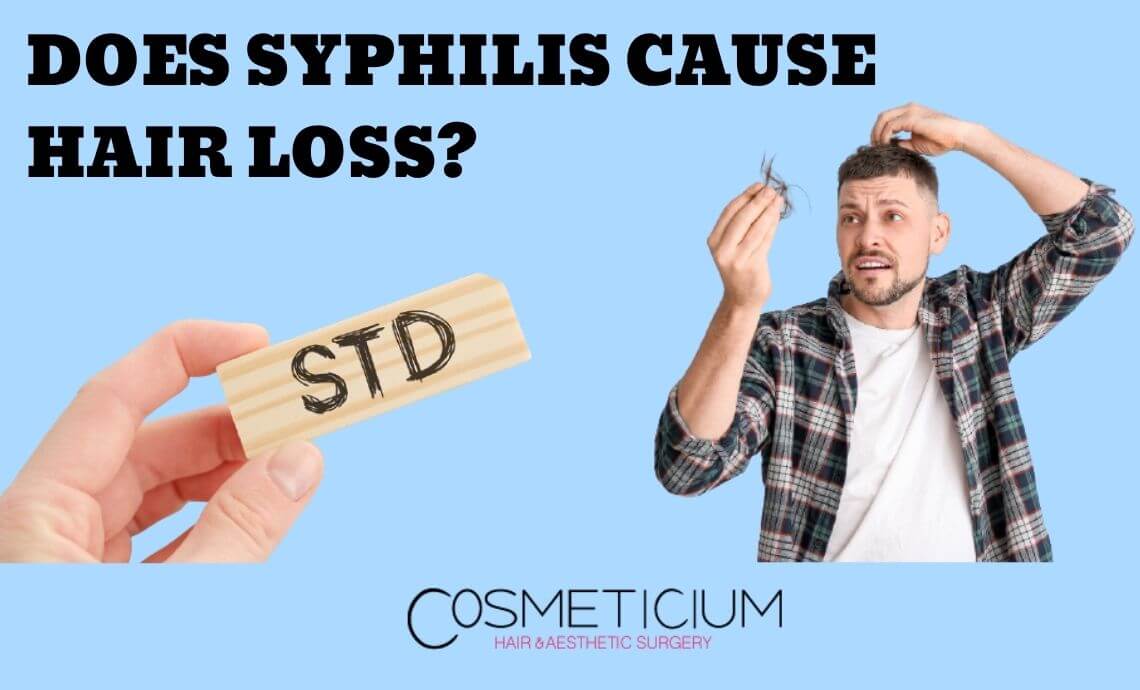Hair loss is one of the important problems that people experience today. Many people lose some of their hair permanently. This problem may have different causes behind. On the basis of these, there may be infection and a similar health problem. Syphilis caused by Treponema Pallidum is one of them. Hair loss can also be seen in those who suffer from the aforementioned disease, and the related condition is called syphilis hair loss. Well, is hair restored after syphilis hair loss? What are the symptoms, diagnosis and treatment of syphilitic alopecia?
Table of Contents
What is Syphilis? | Symptoms
Syphilis is a disease caused by a bacteria called Treponema Pallidum. It is transmitted sexually. Contact with wounds that develop due to the disease causes contamination. There is a treatment, but it can cause serious health problems if not treated properly.
Wounds occur in different body parts of an infected person. These wounds usually occur in external genital organs (anus, vagina and rectum) and around mouth area. Touching these wounds is sufficient to transmit the disease. It is also known to be transmitted by anal, oral and vaginal routes, like other sexually transmitted diseases.

3 Significant Phases of Symptoms
Symptoms apart from syphilis hair loss usually show themselves in 3 stages. Initially, the symptoms are quite mild and may even disappear after a while. In such a situation, patients often think that they have recovered.
In the first period of this disease, or in other words, on average 3 weeks after the contact, a red blister occurs on the genital that is infected with the bacteria. This blister is painless and smooth-edged. In addition to these blisters, a palpable lymph node may also be seen. During the first period, blisters may be painful in approximately 30% of patients.
Treatment should be started from the first time these blisters appear in the first period. If treatment is not applied, blisters disappear completely within 3-6 weeks. Patients think that they have recovered at this stage, but this is a sign showing that the bacteria has spread throughout patient’s body.
The second period of the disease begins 6-10 weeks after the first period. In some patients, the second period may not be seen at all. During this period, symptoms that are similar to flu symptoms are seen. These are:
- Throat ache
- Fever
- Weakness
- Muscle pain
After this period, the disease enters into dormant phase and does not cause any symptom. The disease can only be detected by blood tests.
The third stage of the disease begins after about 3-15 years. The last stage can be fatal. If patient is pregnant, the risk of premature birth, loss of baby and deformity in baby are very high. This phase can show itself in three different ways. These are as follows:
-
Neurosyphilis
The disease affects nervous system. It causes paralysis, dementia, vision problems and psychiatric problems.
-
Syphilis with Gumma
Large, soft tumors called gummas that appear on skin. Sometimes these tumors can also be seen in visceral organs.
-
Cardiovascular Syphilis
This type covers aorta and it can cause aneurysms.
Read Also: How to Track Baldness Correctly?
How Do I Know If I Experience Hair Loss Due to STDs?
 Sexually transmitted diseases show themselves differently. Syphilis hair loss is thought to be one of these symptoms, directly or indirectly.
Sexually transmitted diseases show themselves differently. Syphilis hair loss is thought to be one of these symptoms, directly or indirectly.
One of the symptoms of STDs is hair loss. However, understanding whether hair loss is caused by STD may not be as easy as it seems.
Gonorrhea has different symptoms. However, it is not known whether this infection directly causes hair loss. The same is true for chlamydia. However, azithromycin, a macrolide antibiotic widely used in the treatment of chlamydia, can cause hair loss.
Among the side effects of drugs used in the past for HIV, another sexually transmitted disease, there was hair loss. However, such a side effect is rarely seen in developed and widely used drugs.
There is a relationship between syphilis and hair loss. Depending on the condition of this disease, different types of syphilitic alopecia may occur in people. This can trigger hair loss.
Types of Syphilitic Alopecia (Hair Loss)
Depending on hair loss while frequently seen symptoms of syphilis exist, syphilitic alopecia consists of two types:
-
Essential Syphilitic Alopecia
Conditions in which secondary syphilis hair loss is seen despite the absence of skin lesions on scalp are called essential syphilitic alopecia. This type does not only cause hair loss on scalp. It also affects beard, eyebrows and inguinal region.
-
Symptomatic Syphilitic Alopecia
It is a type of hair loss in which skin lesions are seen on scalp. Syphilis hair loss is seen with symptoms in this type.
Read Also: Causes of and Treatment Methods for Alopecia in Men
What Can I Do to Avoid Hair Loss Due to STDs?
Sexually transmitted diseases are much more common than previously thought. The rate of transmission is high, especially for people who use alcohol and mind-altering drugs. Therefore, the issue of how to be protected from these diseases has great importance.
The rate of spread of such diseases is higher in sexual relations between men. However, heterosexual couples also need to take STDs seriously. Thanks to the developments in medical world, HIV infections have been significantly reduced.
The simplest and most effective way to prevent sexually transmitted diseases is to avoid polygamous sex. Use of condoms during sexual intercourse and other means of protection should not be neglected. It is also known that monogamy significantly reduces the risk.

Read Also: Which Medicines Do Cause Hair Loss?
Can My Syphilis Hair Loss Be Treated?
Syphilis hair loss may differ according to the treatment applied and the stage in which the disease is diagnosed. If a person is diagnosed with secondary syphilis, it can be treated. Even if you experience hair loss, your hair will grow back as your immune system returns to normal after the treatment.
In some cases, hair regrowth after syphilis hair loss can be experienced differently. In some patients, hair starts to grow again after it is completely lost. Therefore, it is important that you act according to your doctor’s instructions and recommendations without worry.
How Is Syphilis Hair Loss Treated?
In the treatment of syphilis, priority is always given to removing the bacteria that causes this disease from body. Antibiotics are prescribed for this. However, additional treatments can be applied to make hair loss reversible. These target hair follicles and are intended to prevent their complete destruction.
PRP is also used for hair loss as it is used for treatments of different diseases. It is one of the most important treatments to be applied to patients who experience syphilis hair loss. After syphilis bacteria is completely eliminated from body, a patient’s blood is drawn and centrifuged. This process separates thrombocytes from plasma. Separated thrombocytes are enriched with necessary components and applied to scalp.
Enriched and injected thrombocyte contains growth factors and other components. These directly affect hair follicles and accelerate hair growth. It also gives very effective results in repairing damaged hair follicles.
CONCLUSION
Syphilis hair loss is a condition that can be seen more often than it is thought. However, with appropriate treatment, hair can grow again afterwards. PRP treatment allows hair to grow back in short time.
 As Cosmeticium, we professionally apply PRP and other treatments needed for syphilis hair loss. Thanks to these treatments applied by our specialist doctors, you can restore your lost hair. In addition, for permanent hair loss, you can consider hair transplantation treatment. To get detailed information about the subject, it is enough to fill out the form below.
As Cosmeticium, we professionally apply PRP and other treatments needed for syphilis hair loss. Thanks to these treatments applied by our specialist doctors, you can restore your lost hair. In addition, for permanent hair loss, you can consider hair transplantation treatment. To get detailed information about the subject, it is enough to fill out the form below.
Fill In The Form Below To Get Answers To All Your Questions About Syphilis Hair Loss From Our Doctors Within Hours. (FREE)

